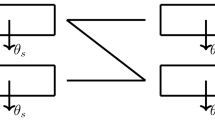Abstract
Consider a system of two queues in parallel, one of which is a ⋅|M|1 single-server infinite capacity queue, and the other a ⋅|G (N)|∞ batch service queue. A stream of general arrivals choose which queue to join, after observing the current state of the system, and so as to minimize their own expected delay. We show that a unique user equilibrium (user optimal policy) exists and that it possesses various monotonicity properties, using sample path and coupling arguments. This is a very simplified model of a transportation network with a choice of private and public modes of transport. Under probabilistic routing (which is equivalent to the assumption that users have knowledge only of the mean delays on routes), the network may exhibit the Downs–Thomson paradox observed in transportation networks with expected delay increasing as the capacity of the ⋅|M|1 queue (private transport) is increased. We give examples where state-dependent routing mitigates the Downs–Thomson effect observed under probabilistic routing, and providing additional information on the state of the system to users reduces delay considerably.
Similar content being viewed by others
References
Abraham, J.E., Hunt, J.D.: Transit system management, equilibrium mode split and the Downs–Thomson paradox. Technical report, Department of Civil Engineering, University of Calgary (2001)
Afimeimounga, H., Solomon, W., Ziedins, I.: The Downs–Thomson paradox: existence, uniqueness and stability of user equilibria. Queueing Syst. 49, 321–334 (2005)
Altman, E.: Applications of Markov decision processes in communication networks: a survey. Technical report no. 3984, INRIA (2000)
Altman, E.: Applications of dynamic games in queues. In: Nowak, A.S., Szajowski, K. (eds.) Advances in Dynamic Games: Applications to Economics, Finance, Optimization, and Stochastic Control, pp. 309–342. Springer, Berlin (2005)
Altman, E., Shimkin, N.: Individual equilibrium and learning in processor sharing systems. Oper. Res. 46, 776–784 (1998)
Armony, M., Shimkin, N., Whitt, W.: The impact of delay announcements in many-server queues with abandonment. Oper. Res. 57, 66–81 (2009)
Arnott, R., Small, K.: The economics of traffic congestion. Am. Sci. 82, 446–455 (1994)
Bell, C.E., Stidham, S.: Individual versus social optimization in the allocation of customers to alternative servers. Manag. Sci. 29, 831–839 (1983)
Ben-Shahar, I., Orda, A., Shimkin, N.: Dynamic service sharing with heterogeneous preferences. Queueing Syst. 35, 1572–9443 (2000)
Brooms, A.C.: On the Nash equilibria for the FCFS queueing system with load-increasing service rate. Adv. Appl. Probab. 37, 461–481 (2005)
Calvert, B.: The Downs–Thomson effect in a Markov process. Probab. Eng. Inf. Sci. 11, 327–340 (1997)
Calvert, B., Solomon, W., Ziedins, I.: Braess’s paradox in a queueing network with state-dependent routing. J. Appl. Probab. 34, 134–154 (1997)
Cohen, J.E., Kelly, F.P.: A paradox of congestion in a queueing network. J. Appl. Probab. 27, 730–734 (1990)
Downs, A.: The law of peak-hour expressway congestion. Traffic Q. 16, 393–409 (1962)
Guo, P., Zipkin, P.: Analysis and comparison of queues with different levels of delay information. Manag. Sci. 53, 962–970 (2007)
Hajek, B.: Optimal control of two interacting service stations. IEEE Trans. Automat. Control 29, 491–499 (1984)
Hassin, R.: Consumer information in markets with random product quality: the case of queues and balking. Econometrica 54, 1185–1195 (1986)
Hassin, R.: Information and uncertainty in a queueing system. Probab. Eng. Inf. Sci. 21, 361–380 (2007)
Hassin, R.: Equilibrium customers’ choice between FCFS and random servers. Queueing Syst. 62, 243–254 (2009)
Hassin, R., Haviv, M.: Nash equilibrium and subgame perfection in observable queues. Ann. Oper. Res. 113, 15–26 (2002)
Hassin, R., Haviv, M.: To Queue or Not to Queue: Equilibrium Behavior in Queueing Systems. Kluwer Academic, Dordrecht (2003)
Ho, B.: Existence, uniqueness and monotonicity of the state-dependent user optimal policy for a simple Markov transport network. MSc Thesis, The University of Auckland (2003)
Koole, G.M.: Structural results for the control of queueing systems using event-based dynamic programming. Queueing Syst. 30, 323–339 (1998)
Kumar, P.R., Walrand, J.: Individually optimal routing in parallel systems. J. Appl. Probab. 22, 989–995 (1985)
Lindvall, T.: Lectures on the Coupling Method. Wiley, New York (1992)
Mogridge, M.J.H.: Planning for optimum urban efficiency: the relationship between congestion on the roads and public transport. Transp. Plann. Syst. 1, 11–19 (1990)
Naor, P.: The regulation of queue size by levying tolls. Econometrica 37, 15–24 (1969)
Parlaktürk, A.K., Kumar, S.: Self-interested routing in queueing networks. Manag. Sci. 50, 949–966 (2004)
Roughgarden, T., Tardos, E.: How bad is selfish routing? J. ACM 49, 236–259 (2002)
Spicer, S., Ziedins, I.: User-optimal state-dependent routing in parallel tandem queues with loss. J. Appl. Probab. 43, 274–281 (2006)
Stidham, S., Weber, R.: A survey of Markov decision models for control of networks of queues. Queueing Syst. 13, 291–314 (1993)
Su, K., Ziedins, I.: (2010, in preparation)
Thomson, J.M.: Great Cities and Their Traffic. Gollancz (1977)
Thorrison, H.: Coupling, Stationarity, and Regeneration. Springer, Berlin (2000)
Wardrop, J.G.: Some theoretical aspects of road traffic research. Proc., Inst. Civ. Eng., II 1, 325–378 (1952)
Whitt, W.: Deciding which queue to join: some counterexamples. Oper. Res. 34, 55–62 (1986)
Whitt, W.: Improving service by informing customers about anticipated delays. Manag. Sci. 45, 192–207 (1999)
Winston, W.: Optimality of the shortest line discipline. J. Appl. Probab. 14, 181–189 (1977)
Author information
Authors and Affiliations
Corresponding author
Rights and permissions
About this article
Cite this article
Afimeimounga, H., Solomon, W. & Ziedins, I. User equilibria for a parallel queueing system with state dependent routing. Queueing Syst 66, 169–193 (2010). https://doi.org/10.1007/s11134-010-9189-7
Received:
Revised:
Published:
Issue Date:
DOI: https://doi.org/10.1007/s11134-010-9189-7
Keywords
- User equilibria
- User optimal policies
- Parallel queues
- State dependent routing
- Downs–Thomson paradox
- Generalized threshold policies




